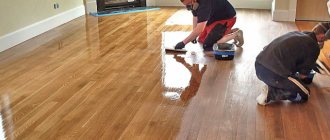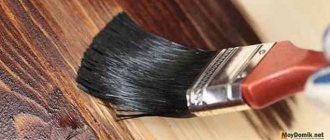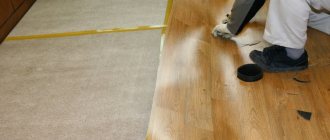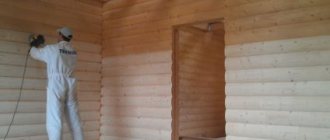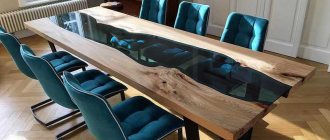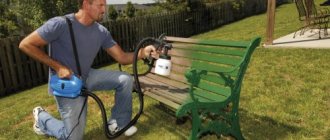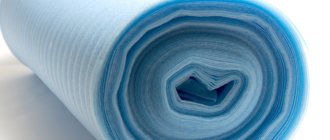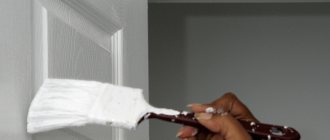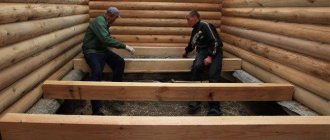Furniture or other interior items made from wood never go out of style. Such products not only look expensive and stylish, but are also environmentally friendly, making them very popular. But wood requires special care, since this material can easily lose its qualities from external factors. Humidity, direct sunlight, and insects have a detrimental effect on wooden products. In addition, wooden furniture can easily become scratched or cracked if not properly cared for. Therefore, in order to preserve the presentable appearance of the item for a long time, it is coated with a special varnish. With its help, a film is formed on the product, which will protect the furniture from damage in the future.
How to restore a wooden table
Before you varnish your dining table or kitchen worktop, you should evaluate the condition very carefully.
The surface may already be painted, mechanically processed, glossy, or varnished. Regardless of what varnish the surface will be coated with, it is necessary to carry out preparatory work. In the video: how to cover a table with stain.
Preparation
The first step is to remove all the old coating. This is done so that the texture of the wood is clearly visible, using an electric tool. When the table is as smooth as possible, the surface does not have any defects, then you can move on to the next stage.
Removing old coating
The chemical remover is applied to the table surface and then wiped off after 10 minutes. To apply and remove a layer of paint or varnish, use a rag.
You can also remove the old coating by sanding. Doing this by hand takes a very long time, so it is better to use a power tool. The work is performed at low speeds so as not to damage the wood.
Varnish application technology
To apply varnish, it is better to use brushes or rollers. Using a colorless varnish for a wooden table in one layer, it is very difficult to obtain the desired shade - this is only possible if you cover the surface in several layers.
After the stains and primers have dried, they can be varnished. The varnish is applied in a thin, even layer, trying to avoid drips. After the first layer has dried, it is recommended to sand the surface. For a high-quality result, varnish in three layers of varnish.
In a day, the old table will turn into a new one and no one will ever be able to say that it is very old. Knowing how to cover a table, you can restore other wooden furniture in this way.
Application Tips
The video discusses the main types of wood varnishes and methods of applying them:
- If the wood has been painted, before applying, you must carefully remove all traces of old varnish.
- To improve drying, it is best to maintain a temperature of about 20 degrees Celsius in the painting area.
- It must be remembered that the product must be well dried before applying varnish.
- For the best effect, each well-dried layer of varnish should be lightly sanded.
- For large surfaces it is recommended to use a roller.
- The surface should not contain any lint, dust, stains, etc.
Today, the basis for the manufacture of furniture and other products is MDF. Varnishing MDF is a common method that gives the product additional strength and stylish appearance, and improves performance. In addition, varnished MDF panels are often used for interior wall decoration. They are ideal for rooms with high humidity.
Thanks to the coating, the service life of the material increases, the material becomes more convenient in further use. The most popular material for cladding many products is veneer; it is a thin cut, in most cases, of noble wood. Coating veneer with varnish is an excellent way to provide the product with reliable protection from various external influences, as well as give it a noble appearance.
Of course, the method of treating wood with varnish is one of the most practical and attractive. And the above information will help you implement it correctly.
Milling Outdoor advertising production
Alternative options
A good alternative to varnish for a kitchen countertop is to impregnate the wood with vegetable oils. Typically, mixtures of tung, linseed, and citrus oils are used.
A good alternative to varnish for a kitchen countertop is to impregnate the wood with vegetable oils.
The main advantages of oil impregnation compared to varnishing:
Environmentally friendly. Oils do not contain harmful substances that are necessary for film formation.
Oils do not contain harmful substances that are necessary for film formation.
Ease of use. Small scratches here are practically not noticeable and do not spoil the appearance. In case of serious damage to the surface, the damaged part can be sanded and then coated with oil again. Moreover, you can do this yourself. When restoring a varnish coating, it is necessary to treat the entire surface completely.
Small scratches here are practically not noticeable and do not spoil the appearance. In case of serious damage to the surface, the damaged part can be sanded and then re-coated with oil.
Oil impregnation does not change color and does not look noticeable, preserving the natural appearance of the wood. Oils can dry completely or partially. In the first case, they form a durable film; in the second, they can be erased from the surface of the wood over time.
Oil impregnation does not change color and does not look noticeable, maintaining the natural appearance of the wood.
How to cover the tabletop
Having decided on the material, you need to understand that the optimal surface for the table will only be natural wood. In no case is veneer, MDF or chipboard used
Particular attention is paid to the age of the tree, its place of growth, storage conditions
Natural wood is the best option for making countertops.
It is important to know that a laminated wood surface will be more elastic and flexible than the same surface made from solid wood. The type of raw material is also important.
Care methods must necessarily include treatment with special protective agents. What is the table covered with? It can be varnish, wax or oil.
There are three options for covering the table surface: varnish, wax and oil.
Practicality or durability
In order not to make a mistake in your choice, you should keep in mind some features of tree species. Harder ones, such as oak or beech, will last longer. However, their cost is much higher.
Hardwood furniture will last longer.
Among the democratic ones, pine, birch, ash or larch are perfect. Speaking about the latter, we should note a number of advantages. Its surface is quite dense and resistant to various types of damage.
The presence of gum in the composition prevents the growth of fungi and mold, as well as rot, which is very important considering where it will be used. Larch is also capable of absorbing or releasing excess moisture.
Larch is also optimal for countertop material.
Oil, wax or varnish
Avoiding the harmful effects of water, temperature, acid and alkali will help extend the life of a wooden tabletop. Here the question immediately arises of how to cover a wooden tabletop so that it lasts a long time.
Among those available, processing using the following means is suitable:
- oil;
- wax;
- varnish
Surface treatment with oil, or rather its impregnation, is the optimal way to protect wooden products. It provides a kind of barrier that repels water from the surface. Oil absorbed into the top layer of wood will prevent it from getting wet when in contact with water. Oil compositions are not washed off, but require frequent use. At the moment, you can choose different compositions that match the color.
Oil protects wood from moisture.
Wax is a natural and environmentally friendly material. The effect of its use is similar to oil. But in addition to protecting against water, the wax coating also protects against minor mechanical impacts (scuffs and scratches). However, there are also disadvantages. A wax coating wears out quickly and requires updating and polishing more often than an oil coating. Before this, the old layer is cleaned off.
The wax coating requires regular updating.
Using varnish on a wooden tabletop is a radical method. It protects wood from water, minor mechanical damage, and exposure to ultraviolet radiation, while the structure of the tree itself does not change. The color of the surface remains the same, and a natural exchange of moisture also occurs, preventing the appearance of fungi and mold.
The varnish protects the surface from all contamination.
This coating also protects against temperature influences without flaking or cracking. To remove the varnish coating, the tabletop will have to be scraped.
Ways to protect wooden surfaces
Kitchen work surfaces are exposed to various liquids, mechanical stress and high humidity every day. To extend the life of furniture, it must be protected with a special compound. Today, the following methods are used to protect wooden products:
- The surface is treated with a special oil, which penetrates deeply into the wood and subsequently prevents it from swelling when the wood comes into contact with moisture or liquids. The following compositions are high-quality and effective oils for treating wooden tables: Belinda, OSMO TopOil, Adler Lengo, etc. For maximum protection, it is recommended to use wax mixtures to cover a wooden table. However, wax and oil provide short-term protection and need to be renewed from time to time.
- The working surface is treated with a special varnish. You can add coloring pigments to the varnish for a wooden tabletop, which allows you to change the shade of the wood fibers and make the surface more saturated. Coating a countertop with a varnish is much easier than treating it with wax or oil.
Oil, wax or varnish?
Caring for and proper use of a wooden countertop will extend its life.
A high-quality coating with good compounds will give a wooden tabletop a beautiful look and protect it from moisture and aggressive detergents.
In order for the tabletop to last longer and maintain its appearance, do not cut anything directly on the wood and do not test the surface for fire resistance and heat resistance.
How to cover a wooden tabletop so that it lasts as long as possible and at the same time remains beautiful?
- Oil, wax.
- Alkyd coatings.
- Water-dispersed compositions.
Depending on the coating, the same type of wood looks different: polyurethane gel, glossy varnish, wood oil
Ideally impregnated with oil, oil-wax. Oil, nourishing the wood structure, gives it water-repellent properties. When properly treated with good oil and wax, the countertop becomes resistant to household chemicals and detergents, which are often used for washing kitchen utensils.
The ideal option for protecting a wooden tabletop is a bio-impregnation based on natural vegetable oils and beeswax.
Apply the oil coating either with a brush or a rag evenly over the entire surface.
A special oil designed to impregnate wood that comes into contact with food will ensure environmentally friendly processing.
Oils for treating wooden countertops can be vegetable, synthetic or mineral
You can apply colored glaze, stain, and other water-dispersed coatings followed by application of varnish. The properties of the varnish used, its resistance to moisture, and multi-layer coating are important.
The varnish treatment option is better because the wood is coated with a protective layer, which is much stronger than oil protection.
A high-quality coating is carried out in several layers - two or three - regardless of the paint composition. Do not mix alkyd and acrylic coatings
Before covering the countertop with the base compound, it is important to select the appropriate primer
Preparing a wooden table for varnishing
You can use a primer that matches the natural color of the wood, or a colored primer that matches the color of the varnish that will be used on the wood.
Advice!
For maximum durability, the coating should be renewed one year after application. It takes time for the product to “get used” to the surface at different temperatures. When exposed to external conditions, microcracks appear on the surface of the coatings, which are visually indistinguishable. Therefore, it will be useful to lightly sand the top layer and apply a new layer with the same composition.
Sand the surface and apply a layer of varnish along the wood grain
Beech wood before and after treatment: on the left – untreated beech, in the center – after treatment with white oil, on the right – oil varnish
The quality of the coating can be tested in the following way: apply a few drops of water to the countertop and observe how quickly they are absorbed. A good coating has excellent water-repellent properties.
Exposure to water can only be short-term - otherwise the wood will have to be sanded and waxed again
It is important to consider the drying time of the compositions; it can vary from several hours to several days. Natural oils and acrylic mixtures have a long drying period or accumulate strength gradually over time, so it is important to limit the use of the countertop during the drying period
It is impossible to protect wood from scratches and mechanical influences with paints and oils, so there is only one way out - treat wooden countertops with the utmost care.
Wooden countertops are an excellent solution for modern kitchens
The slight carelessness of the wooden surface will give the kitchen...humanity. Isn't that what we value most? Humanity... Kitchen? Why not?
A place for wood can be found in a kitchen in any style, it is only important to approach the matter correctly
A wooden countertop in the kitchen is a beautiful and high-quality material that will decorate your kitchen
The best water-based furniture varnishes
V33 matte polyacrylic white
This product from a French manufacturer is suitable for updating the surface of wooden furniture, walls or doors. If the surface has been previously treated, there will be no need for preliminary priming. After the layer has completely dried, a film is formed that is not affected by water, mechanical stress, or dirt. This simplifies the care of the product. In addition, such a varnish coating will not deteriorate from extreme temperatures and will withstand exposure up to 90 degrees.
This model will give the wood a white color that will not turn yellow after several years. "V33 Matte Polyacrylic" is easy to use and does not scratch during application. One liter of this product is enough to cover 12 m2. In this case, the first layer dries in three hours, and it will take a day to dry completely.
The average cost of a 0.5 liter can of metal varnish is 750 rubles.
V33 matte polyacrylic white varnish
Advantages:
- Uniform coverage;
- Almost odorless;
- Dries quickly;
- Thermal and moisture resistance.
Defects:
- Lost.
Chief technologist acrylate semi-matte
This translucent transparent product has virtually no odor, so it can even work indoors. Due to the fact that the product can be safely used to cover furniture or parquet in medical, preschool, food institutions, and also be used in everyday life. After complete drying, a film is formed that is resistant to mechanical stress and does not deteriorate from moisture. With its help, you can not only transform a wooden surface, but also protect it from the aging process. This varnish can also be used for decorative purposes.
Work with this product should be carried out at a temperature not lower than +15 degrees. “Chief Technologist Semigloss Acrylate” can be applied with a brush, roller or spray. Drying one layer takes 30-60 minutes. Complete drying time is 24 hours. For 1 square meter M it takes about 100 grams of product.
The average cost is 500 rubles.
VARNISH Main Technologist semi-gloss acrylate
Advantages:
- Economical consumption;
- Ease of use;
- Doesn't smell;
- Can be used for decorative and protective purposes;
- Affordable price.
Defects:
- Not suitable for garden furniture.
Tikkurila Kiva 70 polyacrylic colorless
This product is suitable for coating wooden furniture, walls, ceilings and children's toys. It has no shadow, but can be created using a special color scheme. It is also worth noting that the coating after such varnish will not turn yellow over time, and when the product thickens, it can be diluted with water.
Tikkurila Kiva 70 Polyacrylic can be applied by spray, sponge or brush. After drying, a durable layer is formed on the product, which will protect the piece of furniture from mechanical stress and prevent it from aging. But to achieve this within two weeks after dyeing, the product will require careful care. So, it will take a day for Tikkurila Kiva 70 polyacrylic to dry completely. Product consumption 8-14 l/m2.
The average cost of a 0.23 liter can is 500 rubles.
Transparent polyacrylic varnish Tikkurila Kiva 70
Advantages:
- Convenient to use;
- Applies evenly;
- Durable coating;
- Dries quickly;
- European manufacturer.
Defects:
- High price.
Neomid Interior polyacrylic colorless
Using this product from the Neomid company, you can create a protective layer on wood products, and also use it for decorative finishing. "Neomid Interior" is suitable not only for covering furniture, it can also be used to paint walls or ceilings. After drying, the film will highlight the natural structure of the wood. It is also worth noting that the varnish layer will have a semi-matte effect and high elasticity. In addition, the product contains bioprotective additives, with their help the coated product will have reliable protection against mold and will not be subject to rotting.
"Neomid Interior" can be used for both home and garden furniture. The manufacturer also provided the possibility of using color. One coat of Neomid Interior requires 60 minutes to dry. One liter of product is enough to cover 5-10 m2.
The average cost is 350 rubles.
Colorless polyacrylic interior varnish Neomid
Advantages:
- No smell;
- Suitable for outdoor use;
- Dries quickly;
- Low consumption;
- Affordable price.
Defects:
- Lost.
Preparing the surface for painting
The countertop that you plan to paint must be clean, intact and dry. Fill all chips and cracks with putty, after drying, clean these places, or better yet, the entire surface as a whole. This will not only get rid of differences and unevenness, but also give the surface roughness, which will improve paint adhesion.
If the tabletop is very old, with multiple damages, and you doubt that you will be able to repair them perfectly, it is better to make an overlay - for example, from an MDF sheet or moisture-resistant plywood. By screwing such an overlay to the surface, you will get a smooth surface ready for painting. Only the edges need to be sealed with putty.
To improve paint adhesion, use a primer that matches the material of the countertop (primer for wood, primer for mineral surfaces, etc.). Or use a universal primer. Allow the primed countertop to dry before you begin painting. Not only the top layer, but the entire countertop as a whole should be dry. Some materials (wood, unglazed ceramics) absorb the primer especially actively, so it is better to continue the work the next day.
Features of table decoration
When the paint is completely dry and hardened, it's time to start decorating. There are several techniques you can use at home. They are good because they do not require expensive investments and are easy to create at home. This is a great option for updating a child's room.
- Decoupage. For this technique you will need napkins with a beautiful pattern, brushes and PVA glue. Select the topmost layer of paper with a decorative element, attach it to the tabletop and apply glue on top with a brush. Make sure that the napkin does not tear, form air bubbles, or move from its original position. After the glue has completely dried, the decorative element is coated with transparent varnish.
- Tulle. Find a piece of tulle with a beautiful pattern. Wet the material, apply it to the table surface and fix it. Using spray paint or a brush, paint the tulle fabric evenly. After drying, remove the improvised stencil. It will look especially impressive if you use contrasting colors of the paint composition.
- Artificial aging of wood looks stylish in a home interior. To do this, sand the surface of the table with sandpaper and wipe certain areas with ammonia. When they darken, go through sandpaper again and varnish.
- Patination. This method produces beautiful, dark, vintage stains on a wooden surface. Apply the patina using stain or other suitable means, wait until it dries and remove unnecessary layers with a foam sponge.
Dyeing technology
Before you paint a wooden table, you need to arm yourself with:
- with a brush, roller and container (if paint is used) or spray (aerosol);
- goggles, mask, gloves, respirator (to avoid toxic substances getting into and on the body);
- antiseptic (necessary for protection against insects) and wood primer (reduces paint consumption).
If you choose the color yourself, apply the mixed paint to the surface and let it dry to understand what the final color will be. Painting the table is done on a hard surface, previously covered with newspapers or plastic wrap to avoid paint getting on the floor.
For those who decide to cover the table with varnish or non-water-based paint, it is better to carry out the restoration outdoors due to the strong toxic odor. If the piece of furniture is large enough, it is better to disassemble it into its component parts using a screwdriver, hammer drill, etc. Many experts argue that it is not worth violating the integrity of a wooden object, since in the future it may lose its shape. However, this statement is controversial. If you assemble all the parts together correctly and efficiently, this will not affect the life of the product, and it will be easier to paint. Before repainting a varnished table, you must remove the old coating. To do this, you can use a chemical solvent, a spatula, or a metal sponge. At the initial stage, sandpaper should be selected coarse-grained, which does not abrade the surface so much. Next, you should sand the surface with fine-grained sandpaper, cover it with an antiseptic and primer and leave to dry. An antiseptic is needed so that pests cannot subsequently reach the wood. After the primer has dried, the surface must be sanded again and wiped with a dry cloth or vacuum cleaner.
Sanding the table surface
The paint is applied in at least two layers
Masking tape is useful if the wooden product has glass or plastic inserts that do not need updating. It is enough to seal unnecessary places and you can proceed directly to painting. If you use aerosol paint, be sure to wear a respirator, goggles and gloves. These methods of protection allow you to paint a wooden tabletop without harm. The substance should be sprayed at a distance of 30 cm from the wooden table. Next, you need to leave the product to dry, and then cover the wooden table with another 2-3 layers of paint. The same sequence is maintained when using conventional liquid paint, which should be applied with a roller or brush with soft bristles. To make sure that the furniture is ready for the next treatment, it is recommended to lightly touch the edge of the surface with your finger. If the paint does not stick, then you can proceed to the next step.
How to paint a tabletop, how to choose a varnish for a table? What varnish to cover the table with depends on the further purpose of the product, but the most universal coating option is acrylic varnish, which will protect the wooden surface from mechanical damage. After painting, you need to remove the masking tape and leave the product to dry for 8 hours (or better yet, a day). Only after this is it ready for use.
Before applying the varnish layer, the table can be decorated with decorative fragments
Tips for choosing varnish color
For beginning craftsmen, a very important question is what shade to choose varnish for a wooden table. The customer must also put an end to this issue. You can not disturb the natural texture of the wood or cover it in the color of cherry or walnut. But you don’t always get the result you expect. To prevent this, you should familiarize yourself with some features:
- Colorless varnish will not always preserve the original appearance of wood. Most often it gives the wooden surface a yellowish appearance. Therefore, if it is necessary to maintain the original shade, it is better to use polyurethane materials. They eliminate the appearance of yellowness.
- When visiting branded stores, sellers will provide a large assortment of colors to choose from. To get the color that you prefer, it is better to take a color that is 2-3 tones lighter. After all, the desired gloss on a wooden surface is formed only after applying 5 or 6 layers. With each subsequent layer, the shade will become darker.
- In the case when 2-3 layers are applied and the result is the desired surface color, but the required gloss is achieved, then this problem can be solved with the help of colorless varnish.
- Varnishing should begin only after high-quality sanding has been completed.
Main types of wood varnish
First, a few words about the functions of furniture paints and varnishes. It is advisable to choose a composition that simultaneously:
- will protect the wooden base of furniture, which is often washed, food is spilled on it, scratched with household items, and heated with hot dishes;
- will improve the appearance of surfaces that are always in sight, maintaining a festive look, shine or velvety matte for a long time;
- will not spoil food, contact of the table surface with food is inevitable, varnish for a wooden tabletop should not contain toxins or other components hazardous to health.
For reference! Paints and varnishes are produced for external and internal work, this is worth taking into account.
Types of varnish coatings used in the production and restoration of wood furniture:
Alcohol based. When dried, the alcohol evaporates from the composition, the dissolved resin hardens, forms a transparent or translucent layer with a glossy sheen. The varnish reliably protects the table base from moisture and mechanical damage. Pleasantly emphasizes the wood texture, slightly thickens the natural shade
When purchasing paints and varnishes, pay attention to the concentration of the base; the recommended alcohol strength is 90%; if lower, the protective layer will not be as strong. It is better to cover the countertop with a concentrated mixture. Oily. Thick varnish is a mixture of resin, pigment and mineral oil (petroleum product)
It is better to work with such paintwork materials outdoors. When dry, the varnish forms a durable film that is resistant to precipitation, ultraviolet radiation, and “kitchen risk factors.” The downside of the composition is its persistent yellowness, which makes the furniture look old. Nitrovarnishes. The basis of the mixture is organic solvents, the film-forming component is cellulose. There are no complaints about the strength or appearance of such coatings, but they are not safe. Organic solvents are too toxic. Harmful components of the mixture will pollute the atmosphere of the room even after the surface layer has completely dried. Due to the persistent odor and toxicity, manufacturers are gradually reducing production volumes of nitro varnish, and demand for it is falling. You should not cover a wooden countertop in the kitchen with this varnish; it is better to choose a safe composition. Water-based paints and varnishes. Water-based varnishes are safe and absorb well into wood. Due to acrylic dissolved in water, after drying the varnishes form a durable polymer film that hardens more and more over time, is heat-resistant, and not prone to abrasion. Water-based acrylic varnish is not afraid of water, it is transparent, and does not change color from ultraviolet radiation. Preserves the original wood grain and emphasizes the texture of the countertop. Polyurethane mixtures. They are elastic, resistant to cracking, and easy to use - no need to prime the wood. The varnish layer is not afraid of accidental impacts, static and dynamic loads. The paintwork dries quickly and does not emit harmful substances. The coating is safe, retains transparency, does not turn yellow, and looks great. But there are also disadvantages: it is better not to purchase polyurethane varnish for a wooden table; the moisture resistance of the coating is quite low.
What types of furniture varnishes are there?
Furniture varnish coatings can be classified not only by composition or color, but also by degree of gloss, method of application and purpose.
If we talk about the effect after coating, then the products are divided into glossy, matte, colored and craquelure varnishes. If you use varnish with a glossy effect, the furniture will reflect light as much as possible, making it the main asset of the room. Using a matte or semi-matte product you can achieve naturalness; such furniture looks good with chrome fittings. The matte option can be used for both home and office furniture. In addition, there will be no hand marks left on furniture coated with matte varnish, and this will help hide minor defects in the product. Using colored varnish, you can choose the desired shade that will fit into the interior. Such products help turn inexpensive wood into an exquisite species. And craquelure varnish will create the effect of cracks on the surface, with its help you can turn a new product into an antique.
Now let's look at the composition of varnishes. Products based on natural oil are classified as oil varnishes. Typically, linseed oil is used here. But now many manufacturers, in order to reduce the price of the product, use synthetic rather than natural ingredients. White Spirit is used as a solvent here. After coating with such a product, the product receives a durable film that will protect against many environmental factors. Oil products can be used for both home and garden furniture. When the solvent evaporates, the layer dries completely, which is one of the main advantages of this varnish.
The next option is nitrocellulose varnish. It can be used for garden and home furniture. To make such a product, resin, colloxylin and organic components are used. It will take about one hour for one thin layer to dry. The result will be a hard and smooth film. It is also worth noting that the nitrocellulose version is very popular due to its lack of odor.
A water-based varnish is considered environmentally friendly. This option is odorless, does not contain toxins and is fireproof. Thanks to these properties, this product can be used for processing furniture in children's rooms. The varnish dries quite quickly and creates a durable and elastic film. Water-based varnishes can be classified into several options according to the type of binder. One such binder is acrylic resin. This option has a milky color, but when it dries there will be a transparent film that will have high strength. This varnish should be used in rooms with low humidity, otherwise the product simply will not dry. There are also varnishes that use polyurethane. The main feature of this varnish is protection against mechanical stress and abrasion.
Varnishes based on alkyd resins protect wood well from moisture. Moreover, such products are easy to apply and tolerate temperature changes well. Alkyd varnish can be used for both indoor and outdoor furniture. But this option requires a long drying time, which is a minor drawback.
If we classify products by purpose, then manufacturers add special components that enhance a certain effect. For example, to use varnish on garden furniture, you will need a water-repellent component. There are also varnishes that are resistant to temperature changes, impact-resistant or weather-resistant.
According to the method of application, products can be divided into traditional varnishes, which are applied with a brush, and aerosol ones. The aerosol version is economical and easy to use. This way you can easily cover hard-to-reach places; when applied, you will get an even layer that dries quickly. Most often, the aerosol version is used when restoring old furniture so as not to damage its surface.
Operating rules
Regardless of which varnish coating option is chosen for the job, certain rules should be followed. Failure to comply with them can lead to poor results, which will subsequently affect the quality of the coating.
First of all, the room where work is carried out must be well ventilated. This condition is important even if the varnish is odorless. In addition, for your own safety, it is better to wear a protective suit and have personal protective equipment. This way, the skin, eyes and respiratory tract will be reliably protected. There should be no sources of fire nearby as the product can easily ignite.
Now you can get to work. But before this, you should remove the old varnish coating from the surface, if any. There should not be even a small uncleaned area left, otherwise the result will not be an even coating. If the product that will be varnished has cracks or small “pits”, then they must be eliminated using putty. Now you can coat the furniture with a layer of primer, after which you can apply the paint product. The layers of varnish should be thin; each new layer can be applied only after the previous one has dried.
If the product will be used in the form of an aerosol, then if you do not have the skills to do so, it is better to practice on an unnecessary board or plywood. Before use, shake the can well. It should be approximately 30 centimeters from the surface where the product will be applied. Movements must be in a horizontal direction. If you hold the can too close to the surface, smudges will appear. After the first layer has dried, you need to sand the surface. And remove all dust using a dry cloth or cloth. Then apply the next layer. If desired, after complete drying, a third layer can be applied.
Varnishing the table top
The varnish can be applied in different sequences. The stain can be used both before the surface is covered with a primer mixture and on top of it.
What is the best way to proceed depends on the wishes of the one who carries out the coating, since there is no difference in the final result.
Since the varnish is applied in several approaches, after the first layer has completely dried, the tabletop must be sanded well.
It is imperative that a primer and stain be used first.
Among other things, their use significantly saves the consumption of varnish, the pricing policy of which is by no means cheap.
When choosing a stain, you need to take into account the composition of the varnish that will be used to cover the wooden table. Alcohol, aqueous and self-diluted solvents are used.
Work order
- To begin, apply a small amount of stain to the countertop. It is necessary to ensure that there are no smudges, droplets or humps on the surface. After application, the surface must be allowed to dry. Depending on the composition, varnish and stain require different times. Since painting is carried out in stages, you need to ensure that each previous layer dries well before applying the next one. This can be determined by touching the base with your fingertip. If it is not sticky, you can continue working. Upon completion, the table should be left to dry thoroughly (24 hours is sufficient). The exception is compositions made on the basis of water or polyurethane.
- If the countertop needs to be shaded, it is recommended to cover it with several layers of stain. With each subsequent layer the surface will become darker.
- To give the tabletop a smooth finish, it must be sanded during operation using sandpaper. This method eliminates unevenness in the surface fibers. But the first sanding is carried out only after the first layer of varnish has been applied and completely dried.
- In general, in order for the coating to be truly durable and to extend the life of the table, it is recommended to cover it with three layers of the product.
The coating can be done on your own, saving some of your finances.
It’s just important not to rush and carry it out according to all the rules.
Coating technology
The video shows how to properly apply varnish to a wooden surface:
The technology of varnishing wood is quite simple - it is a simple process that you can do yourself. To do this, you need to adhere to some tips and certain rules. This process occurs in several stages.
The first is preparing the wood for varnishing; it involves thoroughly sanding the wooden surface; the final result will largely depend on this. Using sanding paper, the entire surface is processed; this is best done with smooth movements along the grain. If you need to sand the holes, use a special stick wrapped in sanding paper. To process convex areas, use a block wrapped in paper. If there are minor scratches or damage on the surface of the wood, they are treated with light-grain paper.
The second is coating the wood with a primer. This reduces the moisture absorption of wood, also reduces varnish consumption, creating a more durable and durable surface. The primer is available both in aerosol cans and in the form of self-prepared solutions. Depending on the type, the primer is sprayed or applied with a brush onto the sanded surface of the wood. After application, you need to wait until it dries completely, and then sand the product again with fine-grained paper.
The nuances of choosing a wooden countertop
So that all of the above problems arise as rarely as possible, and no repair work is required. When choosing a wooden work surface for the kitchen, you need to take into account a number of nuances.
Material. If we talk about wood, the best options are oak, teak, walnut and beech and others. These breeds are strong and durable. But they are also the most expensive. If you choose other options, pine is the best. It contains resins that protect the wood from rotting.
Manufacturing method. Solid countertops (solid), which were mentioned above, are not affordable for everyone. Therefore, in the selection process, people often give options to glued models. The latter, especially if they consist of different types of wood, can combine strength, visual appeal and positive features of all types of wood that compose them. Veneer is a very thin covering of natural wood. In the case of the tabletop, he covers it with a slab of MDF or inexpensive types of wood. Finally, laminated options based on chipboard or MDF are very popular. They have a wide variety of appearances.
How to oil a wooden tabletop?
To ensure that your wooden work surface lasts as long as possible, treat it properly. Everything is important here - the product, the thoroughness of surface preparation, application, drying.
Photo from source: instagram.com
STEP 1: Primary surface treatment
The first stage is cleaning from traces of grease and various contaminants. After this, the wood is dried. To better absorb the oil, the material is sanded. Coarse abrasives are used first and then fine abrasives.
After each abrasive treatment, the wood is cleaned. If deep scratches appear on the kitchen top, they are repaired with putty. Wax-based restoration kits are best suited for this.
STEP 2: Prepare the product for application
Everything is simple here. To prepare the oil for use, stir it for five minutes immediately before applying.
Attention! Quality is the most important thing when choosing oil. Don't skimp on it. A good surface protectant will help avoid damage from moisture and mechanical stress, make the countertop shiny and refresh its appearance.
STEP 3: Apply
Apply the oil composition to the work surface with a cloth or brush.
Attention! Choose a fabric that does not leave lint.
Leave the first layer to dry for at least 12 hours. After this, it will be possible to apply the next one, and proceed similarly to the same principle.
The number of layers you will need is directly dependent on what you are using to apply the oil. For example, if you use a cloth, you will need to apply up to four layers, but if you use a brush, then only two.
Step 4: Dry
It may take from several hours to several days for complete drying, but nothing can be said for sure. However, information regarding the timing must be indicated on the packaging.
Oils with a natural base, as well as mixtures containing acrylic, take the longest to dry. After drying, it is important to wait and not use immediately.
Ways to protect your kitchen work surface
The work area of the room in which food is prepared is exposed to a variety of liquids, so in order for it to serve for a long time, it must be protected from water.
There are several options for this:
- Use oil to treat objects made of wood, which is absorbed into the material and prevents the fibers from swelling when wet. The following industrial products can be used for the wood surface: OSMO TopOil, Belinka, Adler Legno or others. To treat the area to be worked simultaneously with this substance or even instead of it, use specialized wax. But we must not forget that this product will have to be renewed over a certain period of time, in other words, applied again.
- Treat it a couple of times with a special varnish for wooden surfaces. If desired, a little pigment is added to it so that the deep wood fibers become darker, and the surface itself for cooking becomes more expressive.
Oil based coating for kitchen fittings
Oil protects furniture from exposure not only to moisture, but also from chemical, natural and household influences. This factory-made product is largely colorless and may be plant-based, mineral-based, or artificial.
Similar coatings differ from each other in the way they set:
- It dries completely, hardens after drying, it is not possible to wash it off with water and the initial appearance of the finished furniture is preserved for a very long time.
- Absolutely non-drying or half drying, it saturates the wood very deeply. It is made using natural elements. It is removed using the influence of mechanics.
Before applying such a product, the surface to be treated is thoroughly cleaned of all contamination and dried. If there is a need for paint that is already outdated or the varnish will have to be removed. And if there are flaws, then they need to be smoothed out with a specialized putty, and then polished with sanding tape.
The oil is applied using a brush or cloth that does not leave lint, it is applied along the entire length of the fibers. The very first layer should dry for twelve hours, after which a new layer is applied. The total number of them in a given composition depends on the method in which we apply the product itself. If a brush is used, two treatments will be done. And when using a rag, you need to do three or 4 layers. After complete absorption of the composition, the entire treated area should be thoroughly wiped with a soft and clean cloth.
The provided coverage has a number of positive parameters:
- Does not change the color of the surface for working with food, its “pattern” stands out.
- It leaves the first real exchange of moisture in the surface and prevents the formation of fungi, thanks to which the initial appearance of the finished area does not change for a long time.
- If very high temperatures are applied to the outer part of the object for such finishing, then the product does not delaminate and does not leak.
- Furniture oil is considered environmentally friendly, thanks to which the contact of food components with the surface on which the described composition is present will not harm human health.
- Oil hides small scratches, worn areas and stains left by cookware.
- If there is a need to refresh contaminated areas, then you can remove only part of this coating, and then apply it again to the necessary areas.
- The oil is perfect even for aged wood containing pores, since it is deeply absorbed, gives it plasticity and prevents it from drying out.
Manufacturing of countertops
In appearance, furniture made from panel material is not very different from products made from solid wood, but it costs much less. The countertop in the kitchen is exposed to water, steam, and impacts, for example, when beating meat. Even more extreme conditions are found on the countertop in the bathroom, adding humidity and the possibility of household chemicals getting onto the surface.
To make countertops, it is best to use 40 mm thick furniture panels made from oak or beech; ash or larch are also sometimes used.
A tabletop made of valuable wood attracts with its qualities:
- increased strength;
- durability;
- naturalness;
- beauty;
- heat resistance;
- resistance to temperature changes and deformation.
You can choose one of three options for furniture panels:
- extra-class (solid lamella) – homogeneous, without defects in the form of knots and cores, assembled from solid lamellas;
- grade A (joined) – without defects, has an even tone over the entire surface;
- grade B (jointed) – uniform tone, there are a small number of knots.
If two letters are used in the grade marking, for example AA or AB, this means that one side of the board meets the requirements of grade A and another B.
A table top made of extra-class and grade A looks expensive and elegant, while grade B is more natural. The last option can be used, for example, for the LOFT style.
Caring for the countertop surface
It is worth understanding that no matter what material you cover the wooden countertop with, you do not need to cook dishes directly on it - use a cutting board.
Here are some tips to help increase the life of your countertop:
- Use trivets for freshly prepared food. This way you won't see unwanted marks on the surface;
- heating electrical equipment - kettle, toaster, coffee machine - must be placed on a substrate;
- wipe the tabletop along the pattern, that is, along the lines of the fibers - this will definitely remove dirt and grains of sand;
- Do not leave spilled drinks or other liquids on the countertop for a long time. It’s better to clean everything up at once;
- if the windows face the sunny side, then it is better to curtain them with at least translucent fabric - wood fades easily;
- it is necessary to maintain a normal microclimate - the room should not be too dry or humid, otherwise it may affect the countertop. Sudden changes in temperature should also be avoided;
- The surface can be washed with dishwashing detergent. It is practical, fast and does not require large financial outlays;
- full processing can be done no more than once every year. Varnish coating generally once every two years;
- take care to insulate the bottom of the countertop if you have a dishwasher or sink near or under it.
Update
Over time, the countertop still loses its fresh appearance, even if you treat it with the utmost care. The advantage of the countertop is that it can be easily updated.
The operating principle is as follows:
- Clean the tabletop with a grinding machine or sandpaper;
- treat imperfections and defects with putty;
- apply paint with alkyd resin;
- If desired, the plane can be decorated, for example, by drawing something.
Film
Another way to update the appearance of a wooden tabletop is to use self-adhesive film. The advantage of the film is its unlimited number of designs - you can leave a wood pattern or choose an image of marble, stone, leather and even metal. Before gluing the film, it is necessary to clean the countertop and degrease it.
The film must first be measured - it is better to take a little extra. Gluing is done using a plastic scraper, leaving no lumps or folds.
Recovery
If a wooden countertop doesn’t look like new over time, but you don’t want to change its appearance much, then the wood can simply be restored - this is one of its main advantages.
The process is carried out as follows:
- Damaged areas are removed and cleaned;
- The outer part is dried and sanded;
- If there are large voids or dents, fill them with a mixture of sawdust and polyvinyl acetate glue - you can also use regular wood putty;
- Leave the area to be restored under pressure for 24 hours;
- Apply a silicone-based protectant;
- Oil or varnish.
If the damage is very minor, for example scratches, then you can fight it with folk remedies:
- strong black tea;
- walnut kernel;
- machine oil;
- vinegar with olive extract.
If the scratches are deep, it is better to sand them first with sandpaper and then grind them. You can restore shine and gloss with felt.
Combination with plastic
If the damage is very serious, then you can use plastic as a patch for the countertop. Nowadays it’s not difficult to choose the plastic that matches the design; you just need to visit a hardware store.
The damage itself on the countertop is smoothed out, and a “patch” is attached to the top using liquid nails. Glue is applied around the perimeter and in the center. For reliability, a press is placed on top.
What varnish should I use on a wooden tabletop?
Photo from source: tiu.ru
It is recommended to use acrylic or polyurethane varnish. The area treated with them will withstand cold and hot dishes without any problems. It also creates reliable protection against contamination.
To remove the varnish coating, the surface will need to be scraped.

